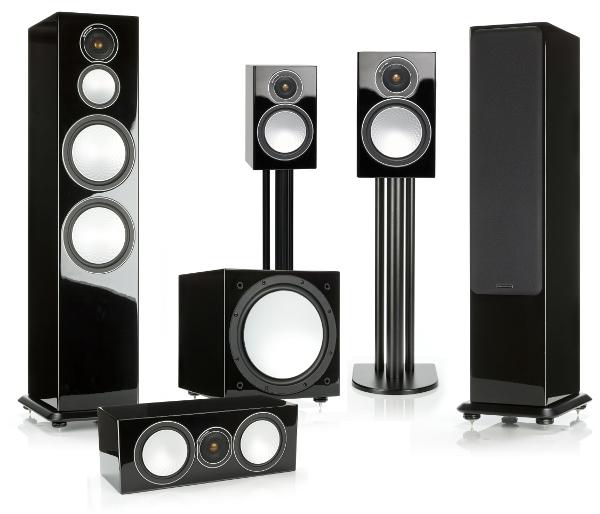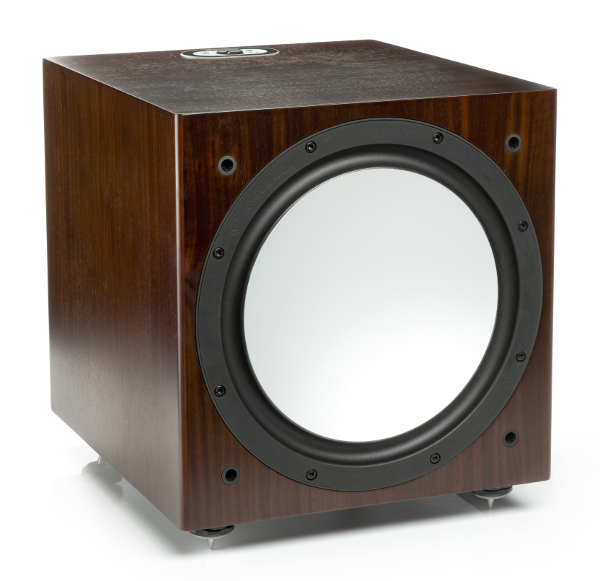Why didn't you at least compared the bi-/dipole speakers in this series? I think they are far better for movie experiences than the direct radiators. I have the RXFX from the former edition of the silvers and it has been a welcome change to my direct radiating speakers.
Monitor Audio Silver 10 Speaker System

AT A GLANCE
Plus
Crisp, open sound
Superb imaging
First-rate fit and finish
Minus
Two-way center channel
Limited subwoofer output
THE VERDICT
The center speaker suffers the usual off-axis quirks of a two-way design, and the small sub came up short for the deepest movie bass, but Monitor’s Silver series is a triumph, a treat to hear, and well worth seeking out for a serious audition.
Monitor Audio offers an exceptionally wide range of speakers, from the decidedly expensive (but not nosebleed high-end) to the modestly priced. In 2010, I reviewed the company’s relatively affordable Silver RX system. That line has now been completely redesigned, losing its RX moniker and morphing into the Silver series. Like the RXs before them, the Silvers were designed at Monitor’s U.K. headquarters and are built in a company-owned plant in China. For this review, we’ve selected the largest of the floorstanders, the Silver 10, along with the Silver Centre, the Silver W-12 subwoofer, and, instead of the Silver FX dedicated surround speakers, a pair of Silver 2s to serve the surround channels.
Silver with C-CAM and Gold
For its loudspeaker cones, Monitor has long used a material they call C-CAM—a thin, light, and rigid alloy of aluminum and magnesium with a ceramic (alumina) layer. The C-CAM cones in the Silvers are dimpled for further strength, a technique the company calls RST, or Rigid Surface Technology. The Silvers’ tweeter domes are also made of C-CAM, despite their gold finish—the latter (not real gold!) a long tradition in Monitor’s designs.
 In a technique now used in most Monitor speakers, threaded rods are fastened to the back of the Silvers’ drivers and extend through the rear of the cabinet, where they are tightened down by visible bolts. The rods hold the drivers securely to the cabinet, provide a clean appearance without the need for visible screws, and perhaps most important, increase the cabinet’s front-to-back rigidity.
In a technique now used in most Monitor speakers, threaded rods are fastened to the back of the Silvers’ drivers and extend through the rear of the cabinet, where they are tightened down by visible bolts. The rods hold the drivers securely to the cabinet, provide a clean appearance without the need for visible screws, and perhaps most important, increase the cabinet’s front-to-back rigidity.
The Silver 10 (shown here in rosenut) is a three-way design, with crossovers at 550 hertz and 2.7 kilohertz. The two-way Silver Centre crosses over at 2.6 kHz, and the two-way Silver 2 (shown on page 2 in rosenut) at 2 kHz. The Silver 10 has two bass ports on the rear; apart from the Centre and the W-12 subwoofer (shown below in walnut), all of the speakers in the Silver lineup are ported. Foam plugs are provided for blocking the ports, which might be beneficial in some situations. I left all the ports open in my setup. Two sets of terminals are provided, allowing for biwiring or biamping, if desired.
The subwoofer’s 12-inch cone is also made of C-CAM. It’s driven by a 500-watt (continuous) Class D amplifier. Despite the W-12’s small size—barely larger than the driver itself—it offers all the inputs, outputs, and controls you’d expect in a full-featured, powered sub. The level control is conveniently positioned on top, along with the control buttons and microphone connector for the W-12’s Automatic Position Correction (APC) feature. The latter provides a degree of automated DSP room equalization and has three operating modes: Music, Movies, and Impact.
All of the Silver series speakers are available in three all-wood veneers or, at extra cost, in either gloss black or white. Ours were walnut, with a gorgeous, reddish stain that led me to believe at first that they were rosenut—another of the veneer options. The grilles (not used for this review) are held in place by magnets hidden beneath the veneer. Overall, the fit and finish of the speakers is impeccable.
Setup
I positioned the Silver 10s at either side of my 96-inch-wide projection screen (retracted during music listening), about 6 feet out from a short wall in my 15.5 x 26 x 8-foot home theater and angled in toward the center seat. The closest sidewall was about 2 feet from the right speaker. Spikes and feet are provided, but I didn’t use them here. The Silver Centre was on a short stand just beneath the screen. I placed the Silver 2s near the back of the room for their surround use.
The W-12 sub rested in the right front corner of the room. I ran its APC calibration procedure with the included mike (you can average up to three positions) and used the Music mode unless otherwise noted. That mode provides a boost centered at 30 Hz (just under 4 decibels, according to a graph in the owner’s manual, and this actually produced the flattest measured bass at my preferred listening positions. While the effect of the APC appeared to be modest, the measured, averaged, in-room bass response of the Silver 10s, supported by the sub in its Music mode and driven at modest playback levels, extended down to 25 Hz.
 The system was driven by an Integra DTC-9.8 surround preamp/processor and a Parasound Halo A51 power amp. The cables, most of them vintage, were from Monster Cable, AudioQuest, Cardas Audio, and Kimber Kable). The Blu-ray players were an Oppo BDP-95 and a Marantz UD7006. For music, I sat centered about 10 feet from the plane of the front speakers; for movies, I sat somewhat to the left of center and slightly further back.
The system was driven by an Integra DTC-9.8 surround preamp/processor and a Parasound Halo A51 power amp. The cables, most of them vintage, were from Monster Cable, AudioQuest, Cardas Audio, and Kimber Kable). The Blu-ray players were an Oppo BDP-95 and a Marantz UD7006. For music, I sat centered about 10 feet from the plane of the front speakers; for movies, I sat somewhat to the left of center and slightly further back.
Music
I began my listening in stereo with the left and right Silver 10s, driven either full-range or crossed over at 80 Hz to the W-12 subwoofer. I definitely preferred the latter, and most of my music comments to follow refer to the front pair with the sub. The Silver 10s alone did reasonably well on some bass cues—drums, for example, were well handled. But the bottom end was a little lumpy, and in my room, at least, the deepest bass just wasn’t there. My in-room measurements in this situation showed a peak at 100 Hz and a response down by approximately 10 dB at 50 Hz (slightly different for the left and right speakers).

However, the bass limitations I heard from the Silver 10s sans subwoofer were not likely typical. The speakers, as noted above, were located a significant distance from the wall behind them, their positions constrained by the need to mate with my ceiling-mounted, retractable screen. Some speakers have performed well in the bass in this location, but not all. Monitor actually recommends and expects placement much closer to the back wall, perhaps 3 feet. Our formal measurements should better show the solo Silver 10’s low-frequency capabilities, but, in any event, no review or reviewer can tell you exactly how the bass of any speaker will sound in your room. [Editor’s Note: Indeed, our quasi-anechoic measurements did show very respectable low-end output for the Silver 10 towers; 3 dB down at 46 Hz and 6 dB down at 36 Hz. So Tom’s in-room performance would seem to be an anomaly. See “Test Bench.” —RS]
A good sub was clearly needed in my situation, and on music the W-12 did the trick. Drums were tight and punchy. Organ had impressive weight, if not quite the “count the cycles” grunt of some bigger subs. But there was never a sense of something missing; the bass was satisfying when present in the source and unobtrusive when not. There was no sign of level compression, and never any real distress on music unless the system was pushed to unreasonable levels.
With the W-12 in tow, the Silver 10s demonstrated that they could compete with the big boys. I used no room equalization apart from that provided by the W-12 for this review, but I did occasionally deviate from zero on the Integra’s treble control, alternating between –1, 0, and +1, but no further, depending on the source. Such deviations will be less than the response changes produced in different rooms.
- Log in or register to post comments






































































